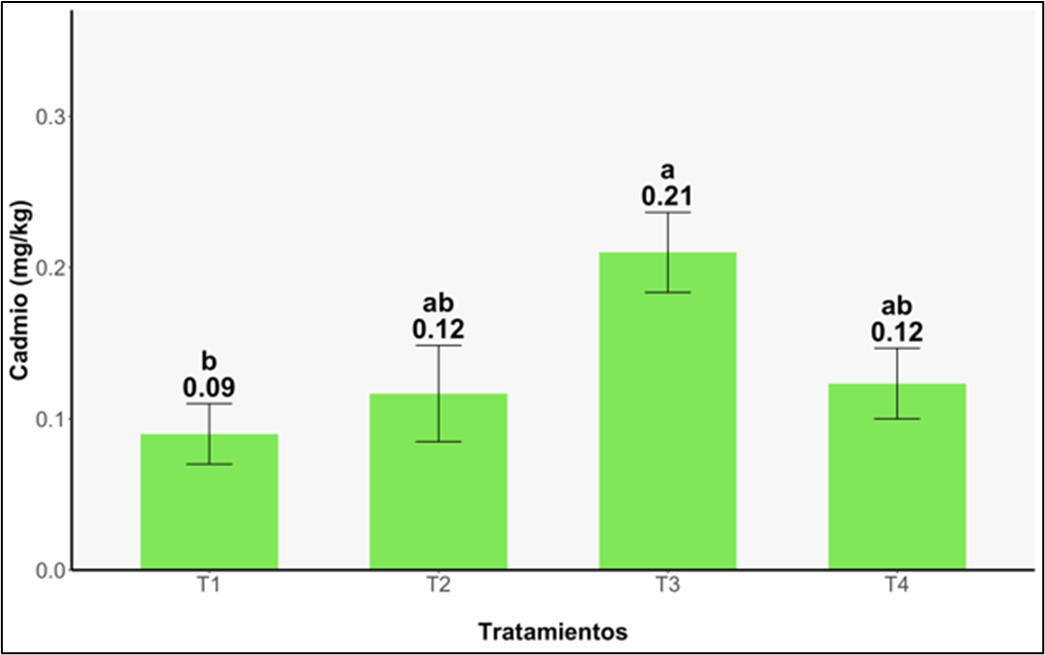Phytoremediation Effectiveness in Contaminated Soils Using Phaseolus vulgaris L. and Zea mays L.
DOI:
https://doi.org/10.51252/reacae.v4i1.903Keywords:
biomass, copper, metals, lead, soilsAbstract
The effectiveness of Phaseolus vulgaris L. and Zea mays L. for the phytoremediation of contaminated soils in Cuñumbuqui, San Martín, Peru, was evaluated. Four treatments were used: T1 (agricultural soil with P. vulgaris), T2 (agricultural soil with Z. mays), T3 (contaminated soil with P. vulgaris), and T4 (contaminated soil with Z. mays), with a completely randomized experimental design and a 100-day period in pots under controlled conditions. The concentrations of copper (Cu), lead (Pb), and cadmium (Cd) in both soil and plants, along with biometric parameters, were measured. Results showed that P. vulgaris in T3 accumulated up to 11.47 mg/kg of copper, while Z. mays in T4 accumulated 5.32 mg/kg of lead. Both crops exhibited low cadmium accumulation. In terms of growth, P. vulgaris reached 42.3 cm in height and 14.6 g of dry weight in T3, whereas Z. mays in T4 performed better, reaching 85.7 cm and 27.3 g. The treatments in contaminated soils were more effective than the agricultural controls, demonstrating that P. vulgaris and Z. mays are viable options for phytoremediation, with P. vulgaris excelling in copper removal and Z. mays in lead accumulation.
Downloads
References
Ayangbenro, A. S., & Babalola, O. O. (2017). A new strategy for heavy metal polluted environments: A review of microbial biosorbents. Environmental Science and Pollution Research, 24(5), 4100-4118. https://doi.org/10.1007/s11356-017-0454-0
Chirinos, C., & Fernández, E. (2022). Metodología de la investigación científica. Editorial Académica Española.
Daryabeigi, Z., & Muhling, K. H. (2022). Heavy metal accumulation in crops and its potential risk in agricultural soil. Environmental Chemistry and Ecotoxicology, 42(1), 37-56. https://doi.org/10.1016/j.ecoenv.2022.113612
Ghosh, M., & Singh, S. P. (2005). A review on phytoremediation of heavy metals and utilization of its byproducts. Applied Ecology and Environmental Research, 3(1), 1-18. https://doi.org/10.15666/aeer/0301_001018
Hu, X., Li, X., & Zhang, Y. (2019). Ecological restoration and phytoremediation of contaminated soils. Environmental Pollution, 246, 223-234. https://doi.org/10.1016/j.envpol.2018.11.039
Julca, H. (2022). El uso de especies nativas en la recuperación de suelos contaminados por metales pesados en la región andina. Universidad Nacional Agraria La Molina.
Landeros, E. A., Ochoa, P. C., & Ramírez, P. F. (2010). Eficiencia de las plantas en la remoción de metales pesados en suelos contaminados. Revista Latinoamericana de Ciencias Sociales y Ambientales, 9(2), 34-45. https://doi.org/10.5897/JLRG.2020.0234
Lasat, M. M. (2002). Phytoremediation of toxic metals: A review of the state of the art. Journal of Environmental Quality, 31(3), 1113-1121. https://doi.org/10.2134/jeq2002.1113
Marques-Benavides, L., García, E., & Gómez, F. (2020). Evaluación de la fitorremediación en suelos agrícolas contaminados. Ediciones Técnicas.
Martínez-Manchego, A., Pérez, D., & Rodríguez, M. (2021). Integración de especies vegetales para mejorar la fitorremediación de suelos contaminados: Un enfoque práctico. Revista de Ecología y Medioambiente, 17(2), 22-31. https://doi.org/10.22201/zemann.2021.172-209
Novoa, M., Chavarría, D., & Ramírez, J. (2022). La fitorremediación en suelos afectados por residuos sólidos en la región San Martín, Perú. Revista de Investigaciones Ambientales, 8(3), 45-56. https://doi.org/10.1146/ria.2022.08.03.045
Salt, D. E., Blaylock, M., & Schaaf, G. (1995). Phytoremediation: A novel strategy for the removal of toxic metals from the environment. Environmental Science and Technology, 29(2), 63-72. https://doi.org/10.1021/es00005a030
Siddiqui, M. H., Al-Whaibi, M. H., & Naz, A. (2020). Phytoremediation of heavy metals: A novel approach for the sustainable management of contaminated soils. Journal of Environmental Management, 273, 12-19. https://doi.org/10.1016/j.jenvman.2020.111078
Wang, F., Wang, S., & Zhang, L. (2019). Phytoremediation of heavy metal-contaminated soils: Advances and future prospects. Environmental Science and Pollution Research, 26(1), 234-248. https://doi.org/10.1007/s11356-019-06945-9
Weyant, P. E. (2022). Climatic and ecological factors influencing phytoremediation efficiency in tropical regions. Springer.
Yao, Z., Zhang, J., & Ma, M. (2023). Phytoremediation of heavy metals in contaminated soils using hyperaccumulator plants: Recent advances and future prospects. Environmental Pollution, 276, 116667. https://doi.org/10.1016/j.envpol.2021.116667
Vizconde-Suárez, M. (2023). Evaluación de especies nativas para la remediación de suelos contaminados en el Perú. Revista Peruana de Ecología, 24(1), 49-61. https://doi.org/10.12804/peecologia.2023.01.049
Zhang, Z., & Chen, J. (2019). The role of phytoremediation in the environmental management of heavy metals. Journal of Environmental Science and Technology, 32(6), 105-115. https://doi.org/10.1007/s11356-019-06880-7

Downloads
Published
How to Cite
Issue
Section
License
Copyright (c) 2025 Lizthky Tatiana Amasifuen-Tanchiva, Luz Felicita De la Cruz-Carranza, Luis Alberto Ordóñez-Sánchez

This work is licensed under a Creative Commons Attribution 4.0 International License.
The authors retain their rights:
a. The authors retain their trademark and patent rights, as well as any process or procedure described in the article.
b. The authors retain the right to share, copy, distribute, execute and publicly communicate the article published in the Revista Amazónica de Ciencias Ambientales y Ecológicas (REACAE) (for example, place it in an institutional repository or publish it in a book), with an acknowledgment of its initial publication in the REACAE.
c. Authors retain the right to make a subsequent publication of their work, to use the article or any part of it (for example: a compilation of their works, notes for conferences, thesis, or for a book), provided that they indicate the source of publication (authors of the work, journal, volume, number and date).



